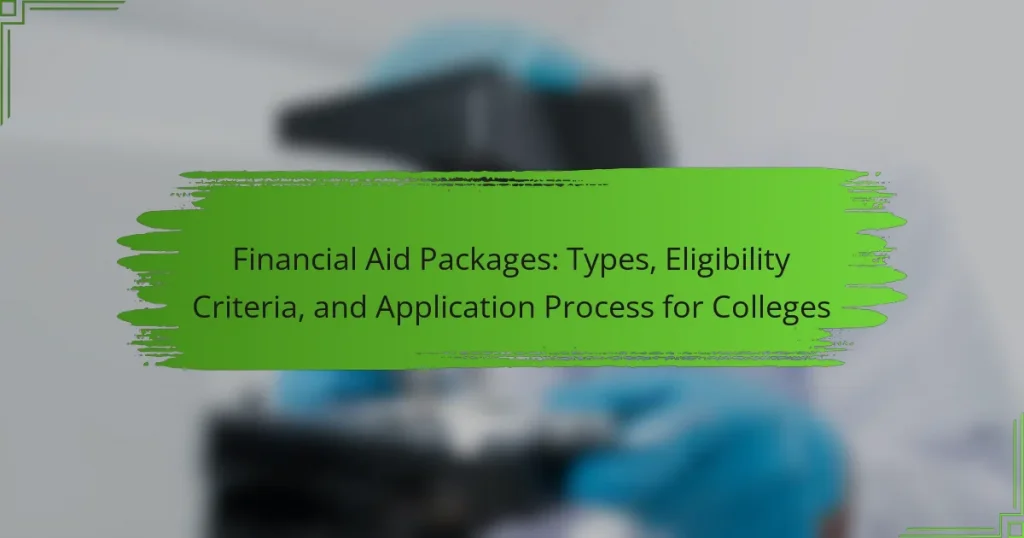
What are Financial Aid Packages?
Financial aid packages are financial support offerings provided to students to help cover educational expenses. These packages can include grants, scholarships, work-study opportunities, and loans. Grants and scholarships do not require repayment, while loans must be repaid with interest. The total amount and types of aid in a package depend on the student’s financial need and eligibility. Financial aid packages are typically awarded after a student completes the Free Application for Federal Student Aid (FAFSA). This process assesses the student’s financial situation and determines the aid amount. According to the National Center for Education Statistics, over 85% of full-time undergraduates receive some form of financial aid.
How do Financial Aid Packages function in the college admission process?
Financial aid packages assist students in financing their college education. They are determined after a student applies for admission and submits financial information. Colleges evaluate this information to assess the student’s financial need. The aid package can include grants, scholarships, loans, and work-study opportunities. Each college has its own method for calculating financial need. The total aid awarded may vary based on the institution’s resources. Financial aid packages are typically communicated in admission letters. Students must accept or decline the offered aid within a specified timeframe.
What components make up a Financial Aid Package?
A financial aid package typically consists of grants, scholarships, work-study opportunities, and loans. Grants are funds that do not need to be repaid. Scholarships are awarded based on merit or specific criteria and also do not require repayment. Work-study programs provide part-time employment to help students cover educational expenses. Loans are borrowed funds that must be repaid with interest. Each component serves to reduce the overall cost of college for students. According to the National Center for Education Statistics, about 85% of undergraduates receive some form of financial aid, highlighting the importance of these components in making education accessible.
How do different types of aid contribute to a Financial Aid Package?
Different types of aid contribute to a Financial Aid Package by providing financial resources to students. Grants are typically need-based funds that do not require repayment. Scholarships are awarded based on merit or specific criteria, also requiring no repayment. Work-study programs offer part-time employment to help students cover educational expenses while studying. Federal loans provide funds that must be repaid, often with lower interest rates. State aid programs may supplement federal assistance, based on residency or specific state requirements. Each type of aid combines to create a comprehensive package that addresses the financial needs of students, making higher education more accessible.
Why are Financial Aid Packages important for students?
Financial aid packages are crucial for students as they provide financial support to cover educational expenses. These packages help reduce the burden of tuition, fees, and living costs. According to the National Center for Education Statistics, approximately 85% of undergraduate students receive some form of financial aid. This support enables students from diverse backgrounds to access higher education. Additionally, financial aid packages can include grants, scholarships, work-study, and loans, which cater to different financial needs. By alleviating financial stress, these packages allow students to focus more on their studies and less on economic barriers. Ultimately, financial aid packages play a significant role in promoting educational equity and access among students.
How do Financial Aid Packages alleviate the cost of college education?
Financial aid packages alleviate the cost of college education by providing financial support to students. They can include grants, scholarships, work-study programs, and loans. Grants and scholarships do not require repayment, directly reducing tuition costs. Work-study programs offer part-time jobs, allowing students to earn money for educational expenses. Loans provide funds that students can use for tuition and living costs, though they require repayment after graduation. According to the College Board, in 2021-2022, 85% of full-time undergraduate students received some form of financial aid, significantly lowering their out-of-pocket expenses. This assistance makes higher education more accessible to a broader range of students.
What impact do Financial Aid Packages have on student enrollment?
Financial aid packages significantly influence student enrollment. They reduce the financial burden on students and families. This makes higher education more accessible. According to a report by the National Center for Education Statistics, institutions that offer substantial financial aid experience higher enrollment rates. Students are more likely to enroll when they perceive that their financial needs will be met. Financial aid packages can also enhance student retention rates. When students receive support, they are more likely to continue their education. Therefore, financial aid packages play a crucial role in shaping enrollment trends in colleges.

What types of Financial Aid Packages are available?
There are several types of financial aid packages available for students. These include grants, scholarships, work-study programs, and loans. Grants are typically need-based and do not require repayment. Scholarships are awarded based on merit or specific criteria, and they also do not require repayment. Work-study programs provide part-time jobs for students to help pay for educational expenses. Loans are borrowed funds that must be repaid with interest. According to the National Center for Education Statistics, approximately 85% of undergraduate students receive some form of financial aid.
What are the different categories of financial aid?
The different categories of financial aid include grants, scholarships, work-study programs, and loans. Grants are typically need-based funds that do not require repayment. Scholarships are awarded based on merit or specific criteria and also do not require repayment. Work-study programs provide part-time jobs for students to help pay for their education expenses. Loans are borrowed funds that must be repaid with interest. According to the National Center for Education Statistics, over 70% of undergraduate students receive some form of financial aid.
What is the difference between grants and scholarships?
Grants and scholarships are both forms of financial aid for education. Grants are typically need-based and do not require repayment. Scholarships, on the other hand, are often merit-based and can be awarded for academic, athletic, or other achievements. Grants are usually funded by the government or institutions. Scholarships can come from various sources, including private organizations and schools. According to the National Center for Education Statistics, approximately 60% of undergraduate students receive some form of financial aid, including both grants and scholarships. Understanding the differences helps students navigate their funding options effectively.
How do loans fit into Financial Aid Packages?
Loans are a key component of financial aid packages for students. They provide additional funding to cover educational expenses after grants and scholarships have been applied. Loans can be federal or private, with federal loans often offering lower interest rates and more flexible repayment options.
In financial aid packages, loans are typically included alongside grants and scholarships to meet the total cost of attendance. The total aid offered may vary based on factors like financial need and the student’s enrollment status. According to the National Center for Education Statistics, about 70% of college graduates in the U.S. have student loan debt.
This statistic underscores the significant role loans play in financing higher education. Ultimately, loans help bridge the gap between available financial aid and the actual cost of attending college.
What is need-based versus merit-based financial aid?
Need-based financial aid is awarded based on a student’s financial situation. It considers the family’s income, assets, and expenses. This type of aid aims to help students who require financial support to attend college. Examples include federal Pell Grants and state grants.
Merit-based financial aid is awarded based on a student’s academic, athletic, or artistic achievements. It does not consider financial need. Scholarships from colleges or private organizations often fall into this category. High GPA, standardized test scores, or outstanding talents can qualify students for merit-based aid.
Both types of financial aid serve to make college more accessible. Need-based aid addresses financial barriers, while merit-based aid rewards excellence and achievement.
How is need-based financial aid determined?
Need-based financial aid is determined by evaluating a student’s financial situation. This evaluation typically involves analyzing the family’s income, assets, and expenses. Schools often use the Free Application for Federal Student Aid (FAFSA) to gather this information. The Expected Family Contribution (EFC) is calculated from the FAFSA data. The EFC represents the amount the family can reasonably contribute to educational costs. Financial aid offices then compare the EFC to the total cost of attendance. The difference between these amounts indicates the student’s financial need. This process ensures that aid is allocated based on individual circumstances.
What criteria are used to assess merit-based financial aid?
Merit-based financial aid is assessed using academic performance, standardized test scores, and extracurricular involvement. Academic performance typically includes GPA and class rank. Standardized test scores may involve SAT or ACT results. Extracurricular involvement encompasses leadership roles and community service. Some institutions also consider artistic or athletic talent. These criteria aim to identify students who demonstrate exceptional abilities. Many colleges publish specific thresholds for these criteria. For example, a GPA of 3.5 or higher may qualify for certain scholarships.

What are the eligibility criteria for Financial Aid Packages?
Eligibility criteria for financial aid packages typically include demonstrated financial need, enrollment in an eligible program, and maintaining satisfactory academic progress. Financial need is assessed through standardized forms like the FAFSA. Students must be enrolled at least half-time in a degree or certificate program. Additionally, they must meet specific academic performance standards set by their institution. Eligibility may also depend on citizenship status, with most aid available to U.S. citizens and eligible non-citizens. Some programs may have age or residency requirements as well.
Who qualifies for financial aid?
Students who demonstrate financial need typically qualify for financial aid. Financial need is assessed through the Free Application for Federal Student Aid (FAFSA). Eligibility often includes U.S. citizenship or eligible non-citizen status. Enrollment in an accredited college or university is also required. Additionally, students must meet academic progress standards. Certain programs may have specific eligibility criteria based on state or institutional requirements. For example, some aid is reserved for low-income families or specific demographic groups. Overall, financial aid aims to support students in accessing higher education.
What factors influence eligibility for Financial Aid Packages?
Eligibility for financial aid packages is influenced by several key factors. These factors include the student’s financial need, which is determined by the family’s income and assets. Academic performance, such as GPA and standardized test scores, also plays a role in eligibility. Enrollment status, whether full-time or part-time, affects the amount of aid available. Additionally, the type of institution, such as public or private, can impact eligibility. Citizenship status is another critical factor; most aid is available only to U.S. citizens or eligible non-citizens. Lastly, specific programs or scholarships may have unique criteria, such as field of study or demographic background.
How does family income affect financial aid eligibility?
Family income significantly impacts financial aid eligibility. Higher family income typically reduces the amount of need-based financial aid a student can receive. Financial aid assessments often use the Free Application for Federal Student Aid (FAFSA) to determine eligibility. FAFSA calculates the Expected Family Contribution (EFC) based on reported income and assets. A lower EFC indicates a greater financial need. Conversely, families with higher incomes usually have a higher EFC, resulting in less financial aid. According to the National Center for Education Statistics, students from families with incomes below $30,000 are more likely to receive substantial aid compared to those with incomes above $100,000. Thus, family income is a crucial factor in determining financial aid eligibility.
What documentation is required to apply for financial aid?
To apply for financial aid, applicants typically need to provide several key documents. These documents often include the Free Application for Federal Student Aid (FAFSA), which is essential for federal aid eligibility. Additionally, applicants may need to submit their previous year’s tax returns. This includes both the student’s and parents’ tax information if the student is dependent. Some colleges require verification documents, such as W-2 forms or other income statements. Proof of citizenship or eligible non-citizen status is also necessary. Lastly, schools may request additional forms specific to their financial aid programs. These documentation requirements can vary by institution, so it is important to check with the specific college or university for their exact needs.
What is the role of the FAFSA in determining eligibility?
The FAFSA, or Free Application for Federal Student Aid, plays a crucial role in determining a student’s eligibility for financial aid. It collects financial information from students and their families. This information is used to assess the financial need of the applicant. The FAFSA determines eligibility for federal grants, loans, and work-study programs. Additionally, many states and colleges use FAFSA data to allocate their own financial aid. Accurate completion of the FAFSA is essential for maximizing available aid. According to the U.S. Department of Education, over 13 million students receive federal student aid each year based on their FAFSA submissions.
Are there additional forms or documents needed for specific aid types?
Yes, additional forms or documents are often needed for specific aid types. For federal aid, the FAFSA is required, but some grants may require supplemental applications. State aid programs might have their own forms, such as state-specific FAFSA versions. Institutional aid often requires additional documentation like tax returns or financial statements. Scholarships frequently ask for essays or letters of recommendation. Each aid type has unique requirements, which can vary widely. It is essential to check the specific requirements for each type of aid. This ensures that applicants submit all necessary documents on time.

What is the application process for Financial Aid Packages?
The application process for financial aid packages typically begins with completing the Free Application for Federal Student Aid (FAFSA). This form collects financial information to determine eligibility for federal, state, and institutional aid. Students should submit the FAFSA as early as possible, ideally by the deadline set by their college. After submission, the college’s financial aid office will review the application and determine the aid package. Students may also need to provide additional documentation, such as tax returns or verification forms. Once the aid package is determined, students will receive a financial aid award letter detailing the types and amounts of aid offered. It is essential to review this letter carefully and respond to any requests from the financial aid office promptly.
How do students apply for financial aid?
Students apply for financial aid by completing the Free Application for Federal Student Aid (FAFSA). This application assesses their financial need. Students can fill out the FAFSA online at the official website. They need to provide personal information, tax information, and details about their schools. The FAFSA opens on October 1 each year. Students should submit it as early as possible for maximum aid eligibility. After submission, students receive a Student Aid Report (SAR). The SAR summarizes their financial information and indicates their Expected Family Contribution (EFC).
What steps are involved in completing the FAFSA?
To complete the FAFSA, follow these steps: First, gather required documents such as your Social Security number and tax returns. Next, create an FSA ID to sign the FAFSA electronically. Then, visit the FAFSA website to start your application. Fill in your personal information, including your financial details. After that, list the colleges you wish to send your FAFSA to. Review your application for accuracy before submitting it. Finally, submit your FAFSA and keep track of your confirmation number. These steps ensure that your application is complete and accurate for financial aid consideration.
How can students ensure their application is accurate and complete?
Students can ensure their application is accurate and complete by carefully reviewing all information before submission. They should verify personal details, such as name and address, are correct. Students must double-check financial information for accuracy. It is essential to follow the specific guidelines provided by the financial aid office. Keeping track of deadlines helps prevent incomplete submissions. Using a checklist can assist in ensuring all required documents are included. Seeking assistance from advisors or counselors can provide additional support. Regularly checking for updates or requests from the financial aid office is crucial for completeness.
What are common mistakes to avoid during the application process?
Common mistakes to avoid during the application process include submitting incomplete applications. Incomplete applications can lead to delays or denials. Another mistake is missing deadlines. Late submissions are often not considered for financial aid. Failing to provide accurate information is also critical. Incorrect data can result in financial aid being revoked. Additionally, not researching available aid options can limit opportunities. Students should explore all financial aid sources. Ignoring application requirements is another frequent error. Each financial aid program has specific criteria that must be met. Finally, neglecting to follow up on application status can leave students uninformed. Regularly checking the application status ensures timely updates and necessary actions.
How can students improve their chances of receiving financial aid?
Students can improve their chances of receiving financial aid by completing the Free Application for Federal Student Aid (FAFSA) accurately and on time. Meeting deadlines is crucial, as many aid programs have limited funding. Maintaining a strong academic record can also enhance eligibility for merit-based scholarships. Additionally, students should research and apply for scholarships offered by private organizations and their intended colleges. Engaging with financial aid offices can provide valuable insights and guidance. Demonstrating financial need through proper documentation is essential for need-based aid. Lastly, students should consider enrolling in community service or extracurricular activities, which can strengthen scholarship applications.
What tips can help students navigate financial aid applications successfully?
Students can navigate financial aid applications successfully by being organized and informed. First, they should gather all necessary documents, including tax forms and identification. Next, understanding the types of financial aid available is crucial. This includes grants, scholarships, loans, and work-study programs. Students should also familiarize themselves with deadlines for applications. Missing a deadline can result in lost funding opportunities.
Additionally, they should complete the Free Application for Federal Student Aid (FAFSA) accurately. Errors on the FAFSA can delay the processing of aid. Seeking help from financial aid offices at their institutions can provide guidance. Many colleges offer workshops and resources for students. Lastly, students should keep track of their application status and follow up if needed. This proactive approach can ensure they receive the financial support necessary for their education.
Financial aid packages are essential financial support offerings for students to help cover educational expenses, including grants, scholarships, work-study opportunities, and loans. This article covers the various types of financial aid packages, eligibility criteria, and the application process, emphasizing the importance of the Free Application for Federal Student Aid (FAFSA) in determining financial need. Key components of financial aid packages and the differences between need-based and merit-based aid are discussed, along with tips for successfully navigating the application process to maximize available funding. Understanding these elements is crucial for students seeking to make higher education more accessible and affordable.




